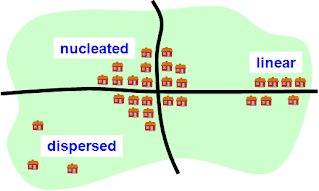Classifying settlements
geography·@donfelix·
0.000 HBDClassifying settlements
A settlement is a place where people live. But it also includes the people who live there, the buildings, the roads, streets and pathways which link up the buildings in the settlement and through which the people communicate. A settlement has a *site* and a *location*. The site is the land area on which the settlement is built, it can be at the base of a hill, by a riverside or a plain. The location is its position in relation to other cultural features or settlement in the region. Let me use major cities in my country as an example. For instance, when we say that Abuja (the capital of Nigeria) is sited on an undulating plain at the foot of Aso rock, we are describing its site. But when we say that it is located at the center of the country and nearly equidistant by air from Lagos, Maiduguri, Sokoto and Calabar, we are describing its location. ## Classification of settlements Settlement are primarily classified according to their *pattern, size* and *housing density*. They can also be classified according to the *functions* they perform. #### Classification according to pattern There are 5 types of settlement classified according to their pattern, these are, isolated, dispersed, nucleated, and linear.  [credit](http://geography.parkfieldprimary.com/_/rsrc/1472778028553/the-united-kingdom/types-of-settlement/typesofsettlement.png?height=191&width=320) An **isolated settlement** consists of a single farm or house very remote from any other one, usually found in farming or hunting rural communities. A **dispersed settlement** is made up of several houses, scattered or dispersed (as the name implies). One house may be up to one or more kilometers from the next. This type of settlement is common in the Sahel. In a **nucleated** or **compact settlement**, the buildings are clustered, linked by roads, and the settlement itself may have a nearly circular or irregular shape. Such settlements can be either cultural or urban, depending on the size and the functions they perform. A **linear** or **elongated settlement** forms a straight or curved line, following a line of movement, such as a road, river, coastline or the foot of an elongated escarpment. This type of settlement is found in rural area, but linear developments may constitute extensions of towns on their outskirts. Finally, the **integrated nucleated** and **linear** settlements combines the characteristics of both types of settlement and they are star-like. They often occur at junctions, and a number of them in urban settlements. No ### Classification according to size and housing density Size and housing density are used together with settlement functions to classify settlements into major categories i.e.rural and urban. *Rural settlements* are often small in size and have low housing and population densities. *Urban settlements* are larger in size and have many houses built close together. ##### Rural settlements can further be broken down into these four grades on the basis of size; homestead*, *farmstead*, *hamlet* and *village*. A **single homestead** has just one compound, usually isolated and owned by a family, and one may be many kilometers from the next. A **farmstead** consist of two or more homesteads, usually dispersed in a farmland and occupied by up to fifty individuals. A **hamlet** is made up of several dispersed, nucleated or linear homesteads generally with shops, schools or other service centers and occupied by some hundreds of persons who are engaged in primary activities like farming, hunting and fishing. A **village**, like a hamlet, may be dispersed, nucleated or both nucleated or linear, but the village has more homesteads and the population may be up to several thousands. The people engage in primary occupations, but there may also be craft and cottage industries, and service centers like schools, post offices, health centers and markets. ###### Urban settlements can equally be graded into four, according to size. These are *towns*, *cities*, *conurbations* and *megapolis*. **Towns** are urban settlements of up to several thousand persons. Houses are built together and the emphasis is more on secondary and tertiary rather than on primary occupation. Usually, a town has large chain stores, and many other social and commercial facilities. **Cities** are the major towns of a country, like the major state capitals which have administrative functions. The old concept of a city being a walled town is no longer tenable as cities are no longer walled these days. They are generally larger than towns. A **conurbation** grows when two or more towns or parts have grown and joined together to form a large urban area of 1 million persons or thereabouts. The boundary between original towns becomes blurred, just like we have in Lagos (Ikeja) and Accra (Tema). **Megapolis** are several cities or conurbations which have grown over the years and have joined together to form a massive sprawling urban settlements. Such settlements stretch over several square kilometers and, as conurbations, it is difficult to known where one original city ends and the other begins. Megapolis is the highest in the hierarchy of urban settlements. Examples are New York-Boston-Philadelphia and Greater Los Angeles (USA), Tokyo (Japan), Greater London (Britain), Mexico City (Central America), and Dusseldolf-Duisburg-Essen-Dortmund, in the Rhur manufacturing region of Germany. #### Reference [Wikipedia](https://en.m.wikipedia.org/wiki/Settlement_geography) https://www.yaaka.cc/unit/analysis-of-settlements/ http://www.pen2print.org/2017/01/classification-of-urban-settlements.html?m=1 My notes on urbanization